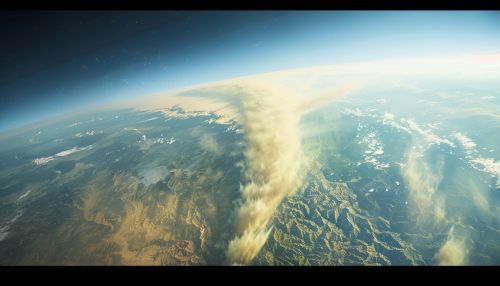Planetary boundary layer
Introduction
The planetary boundary layer (PBL) is the lowest part of the atmosphere and its behavior is directly influenced by its contact with a planetary surface. On Earth, it usually responds to changes in surface radiative forcing in an hour or less. In this layer, physical quantities such as flow velocity, temperature, moisture, etc., display rapid fluctuations (turbulence) and vertical mixing is strong.
Characteristics
The planetary boundary layer is characterized by being in contact with the Earth's surface and affected by diurnal heat, moisture or momentum transfer to or from the surface. The main characteristics of the PBL include its depth, wind profile, and turbulence structure and phase. The PBL depth varies globally and seasonally, but it is typically 1 kilometer deep during the day and a few hundred meters at night. The wind profile in the PBL is typically logarithmic in nature, while above the PBL in the "free atmosphere", the wind profile is geostrophic. The turbulence in the PBL is generated by thermal or mechanical forces, with the former termed "convective turbulence" and the latter "mechanical" or "shear-driven" turbulence.


Types of Planetary Boundary Layer
There are different types of PBL, and the primary distinctions between them are the degree of turbulence and the methods by which turbulence is generated. These include the Convective Boundary Layer (CBL), Stable Boundary Layer (SBL), and the Neutral Boundary Layer (NBL).
Convective Boundary Layer
The Convective Boundary Layer (CBL) is a type of planetary boundary layer that is turbulent and driven by buoyant convection associated with heat from the Sun. This occurs when the surface of the Earth is heated by the sun, leading to an increase in temperature with height, which can create convection and turbulent eddies. The CBL is typically deeper than the stable boundary layer and can extend up to several kilometers.
Stable Boundary Layer
The Stable Boundary Layer (SBL) is a type of planetary boundary layer where the air near the surface is cooler than the air above it. This can occur during clear nights when the ground cools rapidly by radiation, or when cold air flows over warmer surfaces. The SBL is typically shallower than the convective boundary layer, with less turbulence.
Neutral Boundary Layer
The Neutral Boundary Layer (NBL) is a type of planetary boundary layer where the temperature gradient is such that it is neither stable nor unstable. In this case, the forces of buoyancy and mechanical turbulence are in balance. This can occur in regions with strong winds and little solar heating.
Measurement and Modeling
The planetary boundary layer is a critical part of the Earth's atmosphere and understanding its properties and dynamics is important for many applications, including weather forecasting, climate modeling, air quality management, and aviation safety. There are several methods used to measure and model the PBL.
Measurement
Measurement of the PBL is typically done using a combination of ground-based remote sensing instruments like lidar and radar, and in-situ measurements from weather balloons or aircraft. These measurements can provide information about the depth of the PBL, the temperature and humidity profile, and the presence of aerosols or other pollutants.
Modeling
Modeling the PBL is a complex task due to the large range of scales involved, from the small-scale turbulence to the larger scale flow of the atmosphere. There are several types of models used to simulate the PBL, including numerical weather prediction models, large-eddy simulation models, and Reynolds-averaged Navier-Stokes models.
Implications for Weather and Climate
The planetary boundary layer plays a crucial role in the Earth's weather and climate system. It is in this layer that the Earth's surface exchanges momentum, heat, and moisture with the atmosphere, which can influence weather patterns and climate. For example, the depth of the PBL can affect the formation and development of clouds and precipitation. The turbulence within the PBL can also influence the dispersion and transport of pollutants, which can have impacts on air quality and human health.
